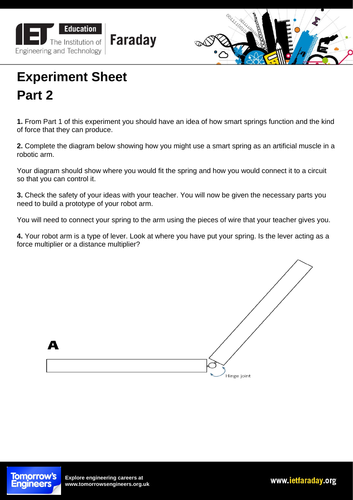



Investigate the properties of smart springs and see how they might be used as muscles in a robotic arm
This fun engineering activity encourages students to investigate prosthetic materials and the properties of smart springs and see how they could be used as muscles in a robotic arm.
This is a free resource aimed at secondary school students. This activity encourages students to investigate the properties of smart materials and carry out some data manipulation. Students will also explore the possible moral and ethical issues associated with people potentially choosing to replace healthy body parts with artificial prostheses because they offer higher performance.
This exercise should take around an hour to complete.
Resources required for class:
Several desk fans should be available but kept out of sight of the students until needed.
Resources required per team:
Wooden ‘arm’ as shown in the diagram on the handout below. These will need to be constructed in advance of the lesson. This could be done either by the science technician or by the students themselves as part of a joint project with design and technology.
1 to 1.5 mm diameter copper or other fairly flexible metal wire. Must be stripped of insulation
A smart spring made from a shape memory alloy such as nitinol
Power supply, leads, crocodile clips
Retort stand
Ammeter
Voltmeter
Sets of slot masses of various sizes
The engineering context
The development of new materials with incredible properties is changing the way we live. From LCD TVs to super light airliners, these materials have quickly found their way into the modern technology around us. One area where modern materials have made a huge impact is in the development of prosthetic devices. Some of these devices are beginning to outperform ‘natural’ body parts.
Suggested learning outcomes
By the end of this activity learners will be able to explain why a material is chosen for a use based on its properties, they will be able to describe how smart materials are used in a real life context and they will be able to use and manipulate material-related data.
All activity sheets and supporting resources are free to download, and all the documents are fully editable, so you can tailor them to your students’ and your schools’ needs.
The activity sheet includes teacher notes, guidance, useful web links, and links (where appropriate) to the national curriculum in each of the four devolved UK nations; England, Northern Ireland, Scotland and Wales.
Please share your classroom learning highlights with us @IETeducation
Something went wrong, please try again later.
This resource hasn't been reviewed yet
To ensure quality for our reviews, only customers who have downloaded this resource can review it
Report this resourceto let us know if it violates our terms and conditions.
Our customer service team will review your report and will be in touch.